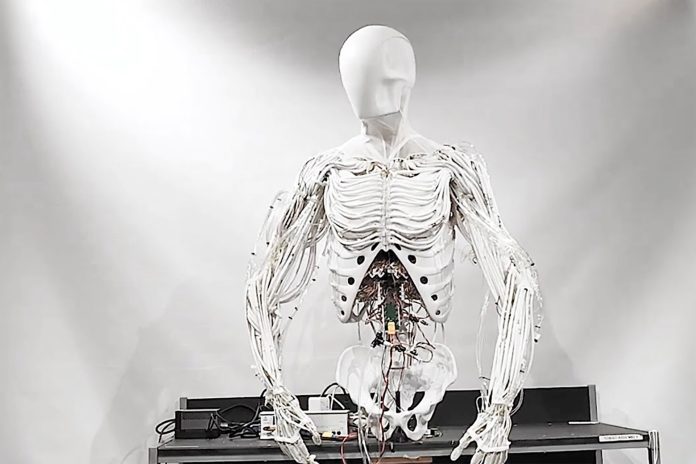Poland-based startup Clone Robotics, founded in 2021, has taken a major step in biomimetic robotics by introducing a humanoid torso capable of lifelike movement. Known for its earlier product, the “Clone Hand,” which simulates human-like dexterity and precision in tasks like ball-catching, Clone Robotics aims to bring similar capabilities to its latest creation: the Clone Torso.
The Clone Torso, equipped with artificial muscles and bones, is designed to replicate the flexibility and strength of human anatomy. Its design includes a rigid spine, rib cage, and a head-like appendage, all covered in a ghostly white “skin” reminiscent of TV androids from shows like Westworld. This ultra-realistic appearance is intended to showcase the potential of humanoid robots in various fields that require human-like agility and control.
A unique hydraulic system powers the Clone Torso, enabling it to perform complex upper-body movements. This system operates through battery-powered water pumps and valves, which push water from a flexible reservoir through the torso’s tubes to create the pressure needed for “flexing” the artificial muscles and activating tendons. The result is a range of motions in the shoulders, neck, and elbows, though the company notes that the arm movements are still somewhat jerky. “Bimanual manipulation training is in progress,” representatives from Clone Robotics shared, indicating ongoing efforts to refine the robot’s fluidity.
Built to be both strong and lightweight, the Clone Torso has a durable skeleton that supports its components without adding excessive weight. With advanced features like an actuated elbow, cervical spine, and anthropomorphic shoulders, Clone Robotics envisions that its robots could play essential roles in industrial and medical environments. For instance, these humanoid robots could potentially replace humans in repetitive or hazardous tasks on assembly lines, offering a safer and more efficient alternative.
Clone Robotics also sees potential in medical applications. Through teleoperation technology, recovering patients might one day use the Clone Torso to perform rehabilitative exercises remotely. This would allow individuals to regain muscle function by controlling the robot’s movements, providing a useful tool in physical therapy settings.
While Clone Robotics has not yet provided information on pricing, the company’s vision is clear: to introduce humanoid robots that assist with everyday tasks, industrial processes, and medical recovery, bridging the gap between human capabilities and robotic assistance.



